PinotFile: 9.12 October 1, 2012
|
California Pinot Noir from A to TThis time of year offers a welcome respite from my usual heavy load of wines to taste and review. It is much too hot to safely ship wine, and everyone in the wine business is preoccupied with harvest anyway. However, before my travels to Oregon in late July and early August, I did have the opportunity to taste quite a variety of wines representing every major appellation in California except Carneros.
Armanino Family Cellars A family owned winery that released its first Pinot Noir with the 2006 vintage. Grapes are sourced from multiple appellations in California. Head Pinot Noir winemaker Chris Nelson has an impressive background, having worked at Lynmar Winery in the Russian River Valley, Dry River Winery in Martinborough, New Zealand, and Araujo Wines in Calistoga. This is my first exposure to the wines from this producer which are well made in their style. They are Syrah-like in intensity, powerful flavored, very ripe, and bombastic, but the high alcohol levels, tannins and oak are all well-integrated.
2010 Armanino Family Cellars The Whitewing Amber Ridge Vineyard Russian River Valley Pinot Noir 15.1% alc., $55. · Dark reddish-purple color in the glass. Bright and inviting aromas of fresh black cherries, black raspberries, black grapes and oak spice. Full-bodied flavors echo the nose with added nuances of dark chocolate, cola and oak. Creamy in the mouth with reserved tannins, finishing with a black cherry theme. Good.
2010 Armanino Family Cellars The Pintail Doctor’s Vineyard Santa Lucia Highlands Pinot Noir 15.2% alc., $55. · Moderately dark reddish-purple hue in the glass. Complex array of aromas including dark berries, briar, wine cellar, violin case and bark. Rich and burly, with copious amounts of sweet, sappy dark berry fruits complimented by a subtle hint of oak. Smoothly textured with mild tannins and some fruit-driven length on the finish. A bit monotone, but hard to ignore the vigorous fruit. Good.
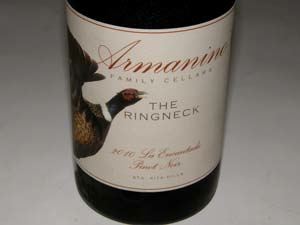 2010 Armanino Family Cellars The Ringneck La Encantada Vineyard Sta. Rita Hills Pinot Noir 14.8% alc., $55. · Moderately dark reddish-purple color in the glass. Very modest and shy nose slowly revealing delicate aromas of cherry cobbler, dark red berry jam and oak over time. Mouth-filling core of sweet blackberry, black currant and black cherry fruit wrapped in modest tannins, finishing with a thrust of intensely flavored fruit. Good.
Baxter Winery A first-rate producer of Pinot Noir sourced from vineyards in Anderson Valley, Mendocino Ridge and Comptche in Mendocino County. Winemaker Phil Baxter, Jr. is a University of California at Davis grad whose unique Pinot Noir regimen includes no new oak barrel aging. The wines are produced at the family farm in Elk, high above the Anderson Valley.
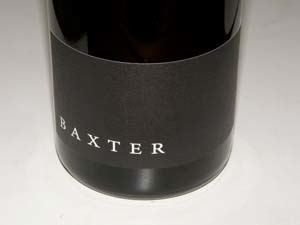 2009 Baxter Black Label Anderson Valley Pinot Noir 14.2% alc., pH 3.71, 500 cases, $35. Sourced from several vineyards throughout the Anderson Valley, a true cross-section of the AVA. 40% Martini, 40% Pommard, 15% “DRC,” and 5% 667 clones. Native yeast fermentations, 6-day cold soak, punched down by hand for 18 days, then pressed using a gentle basket press. Aged 20 months in 100% neutral French oak barrels before blending and bottling. · Medium reddish-purple color in the glass. Brightly perfumed with scents of fresh dark red berries, gentle spice, bramble and flowers. Light in the mouth with flavors of juicy dark strawberries, raspberries and plum and a subtle riff of leafy herbs in the backgrounm showing well-mannered fruit tannins with lively acidity and some length on the refreshing finish. Pinot Noir unplugged (sans oak) offers a different tasting experience. Very good.
Briceland Vineyards One of a small cadre of relatively unknown wineries in Humboldt County, California. Located in the tiny town of Briceland, this winery was founded in 1985 by veteran winemaker Joe Collins and his lifelong partner, Maggie Carey. Collins pioneered winegrowing in southern Humboldt County and he was involved in the establishment and management of practically all the early vineyards in the area. Pinot Noir is sourced from neighbors who farm tiny hillside vineyards in the area. Collins’ stepson, Andrew Morris, is the assistant winemaker. This producer deserves more recognition. The Pinot Noirs, in particular, offer impressive quality at modest prices often unmatched by other California wineries. Joe provided the map below detailing the location of the major vineyards in southern Humboldt County (blue dots).
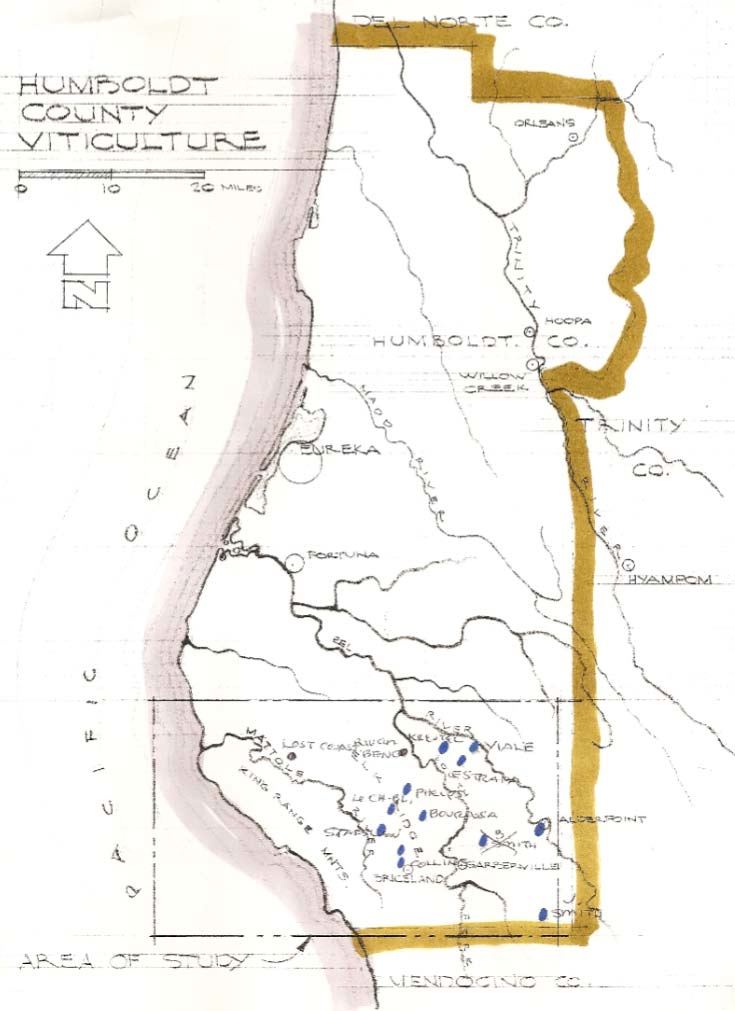
2010 Briceland Vineyards Humboldt County Pinot Noir Table wine, 165 cases, $23. 25th vintage. Season cut short by rain so each of the three vineyards from which fruit was sourced were blended (Phelps, Ronda’s and Elk Prarie vineyards). · Moderately dark reddish-purple color in the glass. The aromatics pick up interest and power over time in the glass offering scents of dark red berries and plums. Discreetly concentrated,sporting ever expanding flavors of dark red berries backed by muscular tannins which need more time to integrate. Finishes with a very pleasing persistence of perfectly ripe fruit. Very enjoyable and equally fine the following day from a previously opened and re-corked bottle. Very good.
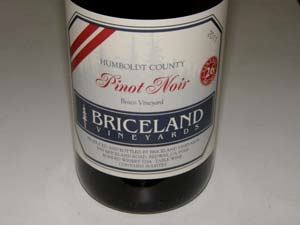 2011 Briceland Vineyards Bosco Vineyard Humboldt County Pinot Noir Table wine, 65 cases, $27. This vineyard is about a mile from the winery on the western side of Briceland. Aged 6 months in oak. · Moderately light reddish color in the glass. A chameleon of a nose, changing constantly, but at times offering aromas of red berries, underbrush, bay leaf, and beet root. Delicious core of savory and spicy dark red berries complimented by a hint of oak. A spirited wine with a wellbalanced tannin load that is soft in the mouth and finishes with modest length. Very good.
2009 Briceland Vineyards Lake County Syrah 14.5% alc., 180 cases, $21. · Dark reddish-purple color in the glass. Aromas of blackberry jam, black currants and white pepper. Soft in the mouth and modest in intensity with a core of sweet blackberry and black grape fruit. Hints of tobacco, pepper and dark chocolate add interest. Noticeable length on the finish that offers a bevy of black fruit and a hint of heat. Good.
Brophy Clark Cellars Husband and wife team of John and Kelly Clark craft small lots of moderately priced Pinot Noir sourced from vineyards in Santa Barbara County. Three wines were favorable reviewed by me in July 2012, but this wine arrived too late to include in that issue.
2010 Brophy Clark Santa Maria Valley Pinot Noir 14.5% alc., pH 3.61, TA 0.62, 300 cases, $24. From the Garey and Goodchild vineyards. Aged 18 months in French oak barrels. · Moderately light reddish-purple color in the glass. Demure aromas of black fruits with a note of cigar box and tarry oak. Respectable, well-spiced, black raspberry and black cherry flavored core, somewhat buried in toasty oak. May improve over time as the oak integrates. Decent.
Cobb A highly popular Pinot Noir specialist producing wines sourced from West Sonoma County vineyards. Ross Cobb, who trained under both Burt Williams and Bob Cabral at Williams Selyem, was the winemaker at Flowers Vineyards & Winery from 2004 and 2008. His Cobb wines are distinctly elegant and balanced with generous aromatics and flavors. The mailing list unfortunately is currently full.
2009 COBB Coastlands Vineyard Sonoma Coast Pinot Noir 13.0% alc., 295 cases, pH 3.38, $70. A variety of Pinot Noir selections from this 15-acre vineyard planted in 1989. Located 4 miles inland from the Coast, the clones planted include Pommard, Martini, Wädenswil and Mt. Eden. Aged 20 months in 35% new French oak barrels. · Moderately light reddish-purple color in the glass. Pungent and shy initially, opening over time to reveal more pleasing aromas of plum reduction sauce. Modest intensity with flavors of dark plum and currant, accented with earthy, oaky notes in the background. Not particular appealing the first day but much better the following day from a previously opened and re-corked bottle displaying more expressive aromas and flavors, veering more to the redder fruit spectrum. Definitely a nervy, higher acid style. Good.
2009 COBB Diane Cobb: Coastlands Vineyard Sonoma Coast Pinot Noir 13.0% alc., 120 cases, $80. A one-half-acre nursery was planted by Diane Cobb with over twenty varieties of Pinot Noir to determine which were best for the Coastlands site. The plantings were later doubled with what she believed was the best in the nursery. This wine is from 1.5 acres as a memorial to Diane Cobb who passed away in 2006. Aged 20 months in 38% new French oak barrels. · Moderately light reddish-purple color in the glass. Enticing scents of dark Queen Anne cherries, sawdust and sandalwood. The dark red cherry core is fresh and vivid, held in check by taut tannins, and finishing strong and focused with a hint of citrus. Seamless with admirable finesse, and a delight to drink. Very good.
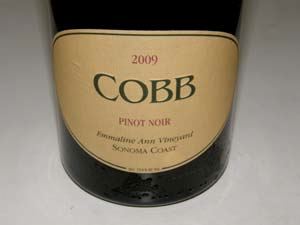 2009 COBB Emmaline Ann Vineyard Sonoma Coast Pinot Noir 13.0% alc., 260 cases, $70. This 3-acre vineyard is located near Occidental on a south-facing slope a few miles inland from Coastlands Vineyard. Dijon clones 115 and 777 are planted in Goldridge sandy loam. At 800 feet, this site is influenced by the Pacific Ocean. More fog and shade than other vineyards Cobb works with giving at a particularly delicate expression of Pinot Noir. Yields are commonly less than 2 tons per acre. Aged 20 months in 30% new French oak barrels. · Light reddish color in the glass. Lovely aromas of fresh cherries, red berries and rose petals with a touch of spice and oak. Highly enjoyable flavors of dark red cherries and berries with a pleasing citrus riff on the cherry-driven, very long finish. Seductively elegant with supple tannins. True to the Cobb style with lighter color, lower alcohol, redder fruits and bright, focused acidity.
Dehlinger An iconic Russian River Valley producer of small lot, hand-crafted Pinot Noir, Syrah, Cabernet Sauvignon, Zinfandel and Chardonnay, with a focus on estate grown wines. The annual production of 7,000 cases is sold primarily to faithful followers on the mailing list. Founded by Tom and Carole Dehlinger in 1975, the second generation of Carmen and Eva Dehlinger are now working in the family business. The winery engages in no expensive promotion so that prices remain reasonable. The wines have a reputation for age ability. The 2010 vintage had poor set caused by frost and rain in the spring and only 43% of normal production resulted. No attempt was made to make up the shortfall at the expense of quality such as adding in some of the press wine or purchasing grapes. Crop size has returned to normal for the 2011 vintage.
2009 Dehlinger High Plains Russian River Valley Pinot Noir 15.4% alc., $60. From the highest ground of the 1989 planting. Usually these grapes are included in the Estate blends or Reserve bottling. 96% Pommard and 4% Swan clone. Yields were 1.25 tons per acre. · Moderately dark reddish-purple color in the glass. Very ripe fruit aromas featuring Bing cherries with a hint of spice and seasoned oak. Rich, long and plush, with copious amounts of black cherry and black raspberry fruit with a sidekick of oak vanillin and cola. The bombastic sap is very seductive and persists on the dry finish which has healthy tannins and a bit of heat. Retasted the following day from a previously opened and re-corked bottle, the fruit veered to the dark (over ripe) side. Good for its style.
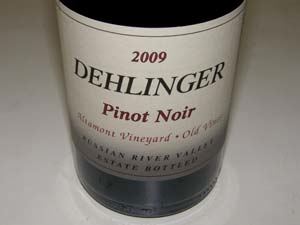 2009 Dehlinger Altamont Vineyard Old Vines Russian River Valley Pinot Noir 14.8% alc., 325 cases, $60. From the original 1975 hillside planting (Pommard, Martini and Swan clones), and the 1982 Octagon planting (Swan clone). Yield was 1.5 tons per acre. · Moderately dark reddish-purple color in the glass. Nicely perfumed with aromas of fresh dark cherries, strawberries and raspberries with a hint of baking spice and a trace of oak. Nicely flavored with a moderately rich core of dark red cherries, red plums and raspberries with a touch of sandalwood, cola and savory herbs in the background. The peacock tail finish is memorable, still evident the following day from a previously opened and re-corked bottle. This wine shows better balance than the High Plains and has more potential for aging. Very good (+).
Eric Kent Wine Cellars I have written extensively about Kent Humphrey and his consistently superb wines. The works of art that grace every front label are quite striking and heighten the drinking pleasure of the wine contained within. His wines (Pinot Noir, Chardonnay and Syrah) are sourced from vineyards in the Sonoma Coast and Russian River Valley and are sold primarily to wine club members. Over time, his wines have taken on a more modest stylistic approach, more reflective of his personality.
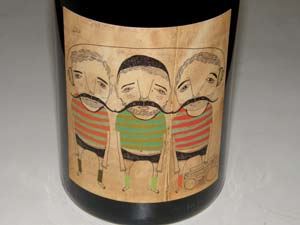 2010 Eric Kent Small Town Sonoma Coast Pinot Noir 14.1% alc., pH 3.65, TA 0.63, 365 cases, $45. Released spring 2012. Label artist is Kelly Puissegur. A blend from two Freestone vineyards (Cleary Ranch and Michael Valentine) with a dose of Roberts Road Vineyard from the Petaluma Gap and Stiling Vineyard from the Russian River Valley. Clones are 39% 777, 28% 115, 19% Swan and 14% 667. · Medium reddish-purple color in the glass. Fresh aromas of blackberries and black plum sauce with a hint of oak. Mid weight flavors of black cherries, black berries and plum reduction sauce with an earthy undertone. Supple tannins, good supporting acidity, and some length on the finish. The wine grows on you over time in the glass indicating more time will reward the patient. Very good.
Ghostwriter Winemaker Kenny Likitprakong crafts small lots of Pinot Noir and Chardonnay from the Santa Cruz Mountains appellation including the Woodruff Family Vineyard which he farms. A native of Healdsburg, he learned his winemaking in the Santa Cruz Mountains a decade ago.
2010 Ghostwriter Woodruff Family Vineyard Santa Cruz Mountains Pinot Noir 13.2% alc., $44. · Light reddish color in the glass. Aromas of strawberries, red cherries, sandalwood and wood spice, with wood predominating over time in the glass. Relatively light in weight, with appealing flavors of ripe strawberries and cherries with oak in the background. Supple tannins with a good spark of acidity make for an easy drinking, food friendly wine. Fashioned for drinking now. Good.
Gundlach Bundschu In 2008, Gundlach Bundschu celebrated 150 years of operation making it California’s oldest family owned winery. The estate 320-acre Rhinefarm Vineyard is located at the southernmost point in Sonoma Valley and its varied terrain allows cultivation of both cool-climate and warm-climate varieties. The single estate Pinot Noir carries a Sonoma Coast designation and contains 20% 40+year-old heritage selections combined with 80% Dijon clones 667 and 777.
2010 Gundlach Bundschu Estate Vineyard Sonoma Coast Pinot Noir 14.4% alc., pH 3.88, TA 0.59, 3,080 cases, $35. 8 blocks harvested separately. Heritage, 115, 667 and 777. 100% de-stemmed, 5-7-day cold soak, indigenous and RC21`2 yeast strains, aged 10 months in 40% new French oak. · Moderately dark reddish-purple color in the glass. Accessible nose with aromas of roasted stone fruits, candied rose and vanilla. Veers to the extreme end of ripeness with flavors of black cherries, dark berries and currants, backed by a hint of oak,displaying fine-grain tannins and a dry finish. Decent.
Gypsy Canyon Owner and winemaker Deborah Hall farms a small estate Pinot Noir and Pinot Gris vineyard on 130 acres tucked away off Highway 246 in the Sta. Rita Hills. A Pinot Noir bottling from the estate Santa Rita Creek Vineyard is offered along with “Trois,” a blend of grapes from three unnamed vineyards in the Sta. Rita Hills AVA. The packaging is quite unique consisting of a hand blown glass bottle with an embossed glass seal, a handmade paper label, and a beeswax seal, all intended to simulate the packaging of early California missionary wines. All the historical aesthetic adds to the appeal of the wine inside. The estate also contains the Dona Marcelina Vineyard, the oldest producing vineyard in Santa Barbara County. Using a recipe written in 1891, Deborah crafts an Ancient Vine Angelica, a fortified dessert wine from the Mission grapes growing at Dona Marcelina Vineyard.
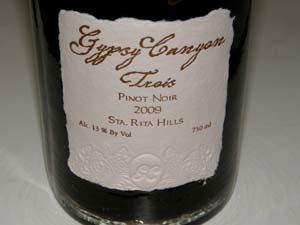 2009 Gypsy Canyon Trois Sta. Rita Hills Pinot Noir 13% alc., $90. · Moderately dark reddish-purple color in the glass. Hi-tone aromas of fresh, ripe black raspberries, blackberries, spice and a subtle green note. Delicious essence of dark berries, with complimentary notes of spice, dark chocolate and cola. Well-balanced with fine-grain tannins and bright acidity. Elegant and refined, with a very dry, fruit-driven finish with admirable intensity. Very good.
Kendric Vineyards Stewart Johnson farms the Kendric Johnson Vineyard located just south of the Petaluma Gap in the Marin County AVA. Planted in 2002, this 8.5-acre vineyard contains multiple clones and yields are painfully low. I have enjoyed every vintage since the first in 2004. A great value among unique California Pinot Noirs.
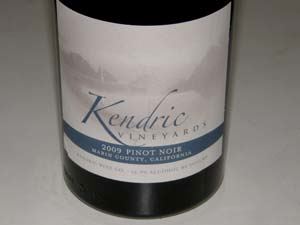 2009 Kendric Vineyards Marin County Pinot Noir 13.5% alc., pH 3.40, TA 0.53, 580 cases, $36. Released fall 2012. 6th vintage. Clones 37, 115, 667, 777, 828, Pommard and Martini. Harvested at about 2.0 tons per acre at about 24º Brix. 60% whole cluster fermentation, 10% saignee, no cold soak, both indigenous and proprietary yeast, 30-day extended maceration, aged in 40% new French oak barrels for 27 months, gently fined and filtered. · Light reddish color in the glass. Very seductive aromas of ripe cherries, red currants, sandalwood and walnuts, picking up interest and intensity over time in the glass. Relatively light in weight but flavorful, offering notes of brandied cherries, spice, and a hint of vanillin oak, with some of the cherry fragrance returning to haunt the finish. Very soft tannins make for easy drink ability. Very good.
Laetitia Vineyard & Winery A very large Central Coast estate, consisting of 1,888 acres of which 620 acres are planted to vines, including the largest privately owned Pinot Noir plantings in California (434 acres). Located 3 miles inland from the Pacific Ocean at an elevation of 255‘ to 720’ the soils are rocky clay loam from volcanic and ocean floor parent material. Pinot Noir vines include Dijon 113, 115, 459, 667, 777, 828, Pommard 5, Wädenswil, Martini 13 and Mt. Eden. Veteran winemaker Dave Hickey started at the winery when it was originally Maison Deutz in 1990, and he now oversees the sparkling wine production while his son, Eric, directs the still wine program. This is one of California’s most consistently reliable producers of sparkling and still wines, and the lineup of wines reviewed here are very impressive. The 2009 vintage offered excellent growing conditions with a daily morning marine layer giving way to cool sunshine in the afternoons. The growing season ended in late September and early October when the grapes were picked during a late season warming trend. 2010 was one of the coolest years on record for Laetitia with many days shrouded in fog until the late afternoon. Aggressive fruit drops were necessary to insure ripening. A late summer heat wave allowed the grapes to properly mature.
2010 Laetitia Estate Arroyo Grande Valley Pinot Noir 14.1% alc., pH 3.76, TA 0.615, 18,000 cases, $25. Released January 12, 2012. 100% de-stemmed, 3-day cold soak, quick fermentation, aged 11 months in 30% new French oak barrels. · Moderate reddish-purple color in the glass. Very aromatic upon opening, offering clean scents of black cherries and black raspberries with hints of dark chocolate, bark and prune. The flavors veer to the overripe side but never cross the line, offering tasty notes of plump dark cherries and berries with a savory mushroom and earth undertone. Silky smooth on the palate with modest length on the bright finish. The longer the wine was in the glass, the better I liked it. An excellent value with wide availability and one of the more consistently reliable Pinot Noir bottlings in the marketplace. Good (+).
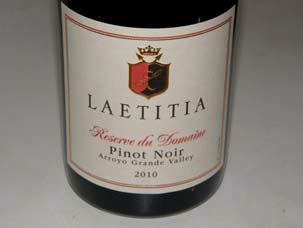 2010 Laetitia Reserve du Domaine Arroyo Grande Valley Pinot Noir 14.3% alc., ph 3.77, TA 0.623, 1,200 cases, $40. Released January 12, 2012. Composed of the most concentrated estate fruit that is given more hang time on the vine and a lengthier time in oak. The wine is a blend of 60% of the same consistent vineyard blocks while the remaining 40% are special lots that stand out with the vintage. Clones are 115, 667, 459, Pommard 5, Wädenswil, and Martini 13. Aged 11 months in 40% new and 60% neutral French oak barrels. · Moderately dark reddish-purple color in the glass. The nose picks up intensity and romance over time in the glass revealing very enticing aromas of perfectly ripe blackberries, clay and forest floor. Delicious, rich core of black cherry and blackberry fruits with a riff of cherry cola on the generous, very slightly hot finish which has noticeable length. The tannins are rather reserved making for good drinking now. Very good.
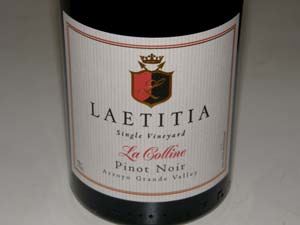 2009 Laetitia Single Vineyard La Colline Arroyo Grande Valley Pinot Noir 13.3% alc., pH 3.43, TA 0.62, 220 cases, $60. Released September 12, 2012. Sourced from original estate plantings. Only made in exceptional vintages. The name, La Colline, means “the hillside” in French. 4-day cold soak, whole berry fermented in small open top fermenters with the addition of RC212 yeast. Gently pressed after 6 days of fermentation and racked into 30% new French oak barrels for an aging period of 11 months. · Moderately dark reddish-purple color in the glass. Very accessible aromas of baked plum, berry pie glaze, musk and oak. Delicious middleweight melange of blue and black fruits, most noticeably raspberries. Very polished and refined on the palate with impeccable balance (no oak or tannin in sight). A slight underlying minerality adds interest. Pleasing persistence and length. A very regal wine that is approachable now, but will benefit from further bottle age.
2009 Laetitia Single Vineyard La Coupelle Arroyo Grande Valley Pinot Noir 14.7% alc., pH 3.55, TA 0.57, 290 cases, $60. Released September 12, 2012. La Coupelle means “the cup” in French. From a protected block located below Les Galets that receives maximum sunlight and is shielded from the cool winds of the Pacific Ocean. Soils are diablo clay and volcanic rock. · Moderately dark reddish-purple hue in the glass. A bit shy, but does offer delicate aromas of dark Bing cherries, raspberries and mushrooms on the grill. Dense, robust flavors of dark berries that exhibit a mouthfilling presence. Notes of cola and dark chocolate arrive as well. Juicy, with firm tannins and modest length on the finish which is a little hot. Good (+).
2009 Laetitia Single Vineyard Les Galets Arroyo Grande Valley Pinot Noir 14.2% alc., pH 3.63, TA 0.55, 276 cases, $60. Released September 12, 2012. Les Galets means “the stones” in French. From low-yielding blocks picked from early to mid October. 65% Dijon clone 115, 35% Wädenswil clone 2A. 4-day cold soak, whole berry fermented in open top fermenters with the addition of RC212 yeast. Aged 16 months in 30% new French oak barrels. · Moderately dark reddish-purple color in the glass. Deeply colored, earth-kissed fruits are featured in this wine which is discreetly concentrated and long in the mouth, with refined, svelte tannins and a vivid, lengthy finish featuring spiced black plums. The fruit has character and noteworthy class. This wine is approachable but still youthful. Very good.
2008 Laetitia Brut Rosé Arroyo Grande Valley Sparkling Wine 12.5% alc., pH 3.08, TA 0.975, 802 cases, $28. Released September 12, 2012. Pinot Noir and Chardonnay were fermented with Prise de Mousse traditional Champagne yeast and stored in stainless steel while the wine underwent malolactic fermentation. It was then racked and filtered and blended with only the brightest, least tannic, lowest alcohol lots of barrelaged still Pinot Noir. Bottled in the spring of 2009 and kept en tirage for 36 months. The still wine component is aged in mature French oak barrels. · Pretty rose-pink color in the glass. Great bead. Lovely aromas of red berries, rose petals and pastry cream. Delicious core of moderately rich tasting red strawberry, cranberry and red raspberry flavors with a hint of pink grapefruit. Dry and uplifting, finishing with some length and a lasting, slightly tart note of citrus-laden berries. I get excited for great Brute Rosé, and this wine is a sublime example.
Meiomi A popular value-priced Pinot Noir from Belle Glos composed of juice from all three of Bell Glos’ California vineyards in Santa Barbara County, Monterey County and Sonoma County. Pronounced “May-OH-mee,” the name is “Coast” in the language of California’s Wappo tribe. Widely distributed and readily available.
13.9% alc., $19, screwcap. 51% Monterey County, 23% Santa Barbara County and 26% Sonoma County. · Deep purple color in the glass. Aromas of black fruits, fig spread, vanilla and caramel. Moderately intense flavors of boysenberries, spice, candied violet, beet root and vanilla. The berry fruit is sappy and delicious and has the signature Belle Glos imprint, but there is too much vanilla from oak on board and the mild confected quality detracts for me. On the positive side, the tannins are well honed and the wine is velvety soft on the palate. Not a classic Pinot Noir by any means, but one that does deliver plenty of sweet, tasty fruit that some may find attractive especially at the modest price. Good.
Patz & Hall A California standard, Patz & Hall has been producing Chardonnay since 1994 and Pinot Noir since 1996. The winery is a joint effort between winemakers James Hall and Anne Moses, and the sales and marketing team of Donald and Heather Patz. The winery sources grapes from about 15 prestigious vineyards located in regions ranging from the Santa Lucia Highlands north to Mendocino County. Although known for distinctive single vineyard bottlings, the lesser priced Sonoma Coast appellation Pinot Noir is a consistent performer year after year. With the 2010 vintage, all fermentations are indigenous, the result of moving into a new winery in Sonoma a few years ago. James Hall believes the 2010 wines are “across the board some of the best wines I have made.”
2010 Patz & Hall Sonoma Coast Pinot Noir 14.5% alc., $45. Fruit from Gap’s Crown Vineyard is a major element in this wine, which also includes grapes from winegrowers like the Duttons, Martinellis, Charlie Chenoweth and Steve Hill. The season produced a concentrated crop with small berries and thick skins to this vintage Pinot Noir is one of the most extracted expressions of this wine ever. Wild and cultured yeast fermentations. Aged in 45% new French oak barrels. Unfined and unfiltered. · Moderately dark reddish-purple color in the glass. A full-bodied arsenal of dark berry, fruit leather, spice and raisin aromas and flavors with an earthy, forest floor undertone. A burly wine that makes no apologies for its copious fruit and tannin. Lacking finesse and nuance, it nevertheless accomplishes it’s goal in this very cool vintage. Good.
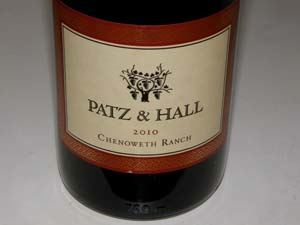 2010 Patz & Hall Chenoweth Ranch Russian River Valley Pinot Noir 14.8% alc., 814 cases, $55. Wild and cultured yeast fermentations, 10% whole clusters, aged in 60% new French oak barrels, bottled without fining or filtration. First designated as a single-vineyard bottling in 2004. This 7-acre vineyard is planted in Goldridge soils at the far western edge of the Russian River Valley AVA (Green Valley) overlooking the Chenoweth family’s homestead. It is farmed exclusively for Patz & Hall. Dijon clones. · Moderately dark reddish-purple hue in the glass. Upon opening, the nose is an array of savory notes of briar, Herbs de Provence and dairy, becoming more fruity over time exhibiting aromas of lovely, spiced raspberries. Upon entry, the wine immediately grabs your attention with ever expanding, palate satisfying flavors of dark cherries and dark red berries complimented by a hint of oak-driven vanillin and maple. Beautifully composed with balanced, suave tannins and focused acidity, finishing with a long and amorous kiss of black cherries. An exceptional wine that will reward furthering cellaring.
Paul Lato I usually taste Paul’s latest releases each March at the winery in Santa Maria, but this past March when I was traveling in the area the wines had just been bottled, and Paul preferred not to show them. Six months later, I tasted several of the 2010 Pinot Noir releases at home and the wines were stunning, among the finest Pinot Noirs being produced in California today. Beginning with a six-barrel production in 2002, Paul has progressed to 52 barrels for the 2010 vintage, which includes two Chardonnays and seven single-vineyard Pinot Noirs. He has been able to quit his sideline day job at another winery and devote his attention full time to his own label where he thoroughly enjoys his hands-on work in the cellar. The wines are expensive, sell out instantly when offered, and are only sold through a mailing list. A careful search may turn up a few bottles in the retail market. Almost from the beginning, Paul Lato Wines have been served in three-star Michelin restaurants including The French Laundry, Per Se, and the Meadowood Resort. The 2010 wines were sold for the first time internationally to the best restaurants in Stockholm, Copenhagen and Tokyo. Paul only makes a few barrels of each vineyard-designated Central Coast wine so there is not a lot to go around. You don’t see many pinotphiles selling Paul Lato wines on the secondary market because they are just too good. The 2010 wines reviewed below drink well now but will age. Like always, Paul’s wines have harmony and balance. A cut above. (Other 2010 Paul Lato wines offered and not reviewed here are “Belle du Jour” Hilliard- Bruce Vineyard Sta. Rita Hills Chardonnay, “Le Souvenir” Sierra Madre Vineyard Santa Maria Valley Chardonnay, “The Prospect” Sierra Madre Vineyard Santa Maria Valley Pinot Noir, and “Lancelot” Pisoni Vineyard Santa Lucia Highlands Pinot Noir)
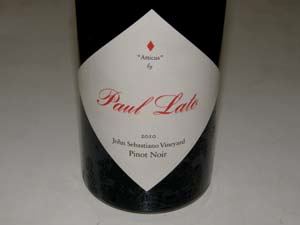 2010 Paul Lato “Atticus” John Sebastiano Vineyard Sta. Rita Hills Pinot Noir 14.5% alc., 125 cases, $65. · Dark reddish-purple color in the glass. Masses of perfume emerge over time in the glass revealing scents of perfectly ripe dark berries, black currants, wood shed and spice. Mouthfilling flavors of blackberries and black plums with an earthy undertone, expanding in the mouth and lingering long and stout on the finish. Very silky on the palate with suave tannins. A harmonious wine with a fruit core that is extremely pure and vivid.
2010 Paul Lato “Seabiscuit” Zotovich Vineyard Sta. Rita Hills Pinot Noir 14.5% alc., 75 cases, $65. · Dark reddish-purple robe in the glass. Glorious aromas of dark red and black stone fruits and dark strawberries, with hints of spice, red rose petals, and forest floor. Intense and sappy on the palate with luscious black cherry and blackberry flavors, lifted by bright acidity and complimented by ripe tannins. The fruit intensity is stunning but not jammy, and beholds an intensity that lasts and lasts on the peacock tail finish. A thoroughbred.
2010 Paul Lato “Alegria” Hilliard-Bruce Vineyard Sta. Rita Hills Pinot Noir 14.5% alc., 75 cases, $70. · Moderately dark reddish-purple color in the glass. Very expressive nose, offering hi-tone aromas of berry tart, dried rose petals, malt and vanilla. Moderately flush with well-ripened dark red and black berries including ollaliberries, with an accent of new oak and an earthy underbody. Smooth and seamless and quite enticing, although not quite as expressive as the other wines in this vintage. Very good.
2010 Paul Lato “Duende” Gold Coast Vineyard Santa Maria Valley Pinot Noir 14.3% alc., 75 cases, $60. · Moderate reddish-purple color in the glass. A feminine perfume of ripe Queen Anne cherries with an exotic array of spices. Stunning entry, with delicious dark cherry, black raspberry, ripe strawberry, stem and white chocolate flavors, enriched by lively acidity and framed by soft, rich tannins. Amazing fruit clarity and intensity. The most expressive wine immediately upon opening among those tasted at this session. Plenty of pinotosity at work.
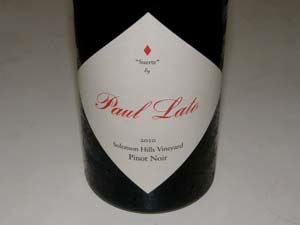 2010 Paul Lato “Suerte” Solomon Hills Vineyard Santa Maria Valley Pinot Noir 14.5% alc., 150 cases, $70. · Dark reddish-purple color in the glass. The nose is brooding initially, opening over time to reveal very appealing aromas of spiced berry cake, forest floor and cedary oak. Moderately rich core of dark cherry, berry and plum flavors with a hint of oak vanillin. Think sweet blackberries with fresh cream. Gathers intensity and interest over time in the glass, reaching a state of flamboyance that is striking. Seamless, with well-managed fine grain tannins and integrated acidity. Finishes long and scented. Tasted the following day from a previously opened and re-corked bottle, the wine was even better, continuing to pump out the pleasure at a welcome pace. My favorite by a hair among the five wines reviewed here.
Radio-Coteau Owner-partner and winemaker Eric Sussman has a varied training background, having spent time in Burgundy at Comte Armand in Pommard, Domaine Jacques Prieur in Meursault, and Dehlinger in the Russian River Valley. The name, “Radio-Coteau” is two conjoined words derived from the Rhone region of France, literally translated as “broadcasting from the hillside.” The inaugural Pinot Noir releases were from the 2002 vintage. The focus is on vineyards in the Sonoma Coast, Russian River Valley and Anderson Valley.
2010 Radio-Coteau La Neblina Sonoma Coast Pinot Noir 13.6% alc., 894 cases, $45. 100% Hallberg Vineyard. Dijon clones 777 and 115. Aged 15 months in FRench oak barrels. Unfined and unfiltered. · Moderately dark reddish-purple color in the glass. Very perfumey and floral with added aromas of orange blossoms and candied, spiced raspberries. Moderately rich, featuring sweet, sappy black raspberry and plum fruit flavors that pick up intensity over time in the glass. A fruit and floral driven wine that is soft and gentle in the mouth. Good.
Sean Thackrey Thackery is an eccentric, even maverick winemaker who crafts his distinctive wines at his home in the small town of Bolinas in Northern California. In his bib overalls, he strikes you as a farmer, but when you speak with him he impresses you as a scholar. His website offers an extensive history of winemaking and the understanding of wine, but no information on Thackrey’s own wines. He has crafted a Pinot Noir (Andromeda) from Devil’s Gulch Vineyard in Marin County since 2002. The wine reviewed here from Anderson Valley is the inaugural release.
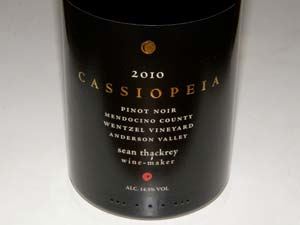 2010 Sean Thackery Cassiopeia Wentzel Vineyard Anderson Valley Pinot Noir 14.3% alc., $45. Named for the constellation, this is Thackery’s newest project, conceived as an exploration of clonal influence. There are five wines that make up the Cassiopeia project: four made from a single Dijon clone (114, 115, 667 or 777) all grafted to identical rootstock, planted at the same time, farmed identically and subject to the same exposure at the Wentzel Vineyard. This, the fifth wine, is a blend of all four clones to demonstrate how the characteristics of each informs the wine. · Moderately light reddish-purple color in the glass. Aromas of dark red berries, briar, oak, herbs, and exotic flowers. Medium bodied flavors of dark red cherries and berries with a backing of savory herbs. A bit exotic and intriguing. Lovely soft and polished mouthfeel. More expressive aromatically the following day from a previously opened and re-corked bottle. Very good.
Small Vines Wines Paul and Kathryn Sloan are owners of Small Vines Viticulture, established in 1998 to plant and manage ultra high density planted vineyards in the Russian River Valley and Sonoma Coast appellations. The company’s motto is, “The smaller the vine, the better the wine.” Byron Kosuge is the consulting winemaker. The wines are offered from vineyards that Small Vines Viticulture farms and are sold through a mailing list.
2010 Small Vines Baranoff Vineyard Russian River Valley Pinot Noir 13.9% alc., pH 3.73, TA 0.56, <100 cases, $65. Mostly Calera with some 115 and 777 clones. High-density plantings (2722-3630 vines per acre). Native yeast fermentations, aged 15 months in 33% new French oak. 100% free run. · Medium reddish-purple color in the glass. Vibrant aromas of dark red cherries, rose petals, and oak spice. A hint of apple core detracts. Middle weight flavor of black cherries with a complimentary hint of oak. Admirable finesse with mild tannins and some staying power on the fruit-driven finish. Better the following day from a previously opened and re-corked bottle. Good (+).
2010 Small Vines MK Vineyard Sonoma Coast Pinot Noir 14.1% alc., pH 3.78, TA 0.54, 143 cases, $65. Dijon clones 114, 115, 667 and 777. Native yeast fermentations, aged 15 months in 50% new French oak. 100% free run. · Medium reddish-purple hue in the glass. Aromas of mixed berry compote, shrub and oiled wood. Moderately rich core of darker berries with a hint of old wood and stem, fashioned in an elegant style, yet displaying a healthy tannic presence. Better the following day from a previously opened and re-corked bottle with better integration of tannins. Needs more time in the cellar. Very good.
Stomping Girls Wines Uzi and Kathryn Cohen were inspired to start their own winery by three generations of family winemaking history. The name honors Uzi’s winemaking grandmother, Esther, his sister who stomped the grapes, and the “stomping girls,” the Cohen’s daughters who worked in the cellar. Stomping Girl Wines was founded in 2008. The wines are produced from purchased grapes.
2010 Stomping Girl Unhinged Sonoma County Pinot Noir 14.4% alc., pH 3.76, TA 0.573, 200 cases, $28, screwcap. From several small family owned vineyards (Corona Creek, Lauterbach and Beresini). 100% de-stemmed, 4-day cold soak, native yeast fermentation, aged in mostly neutral French oak barrels. Unfined and unfiltered. · Moderately light reddish-purple color in the glass. A commendable, simple and straightforward offering, with aromas and flavors of black cherries, dark raspberries, and subtle oak. The middleweight core of fruit is wrapped in polished tannins leading to a smooth, satiny mouth feel. Nothing is out of place. Good (+).
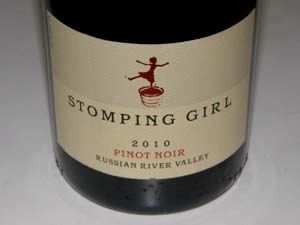 2010 Stomping Girl Russian River Valley Pinot Noir 14.4% alc., pH 3.80, TA 0.53, 100 cases, $36. 86% Lauterbach Hill Vineyard and 14% Beresini Vineyard. 100% de-stemmed, 4-day cold soak, native and inoculated yeast, aged in most neutral French oak barrels for 15 months. Unfined and unfiltered. · Moderately light reddish-purple color in the glass. Very savory nose featuring aromas of brier, herbs, spice and Bing cherries. Moderately rich core of dark red cherries and berries with modest finishing strength. Notes of cola and spice add interest. Soft and smooth on the palate with supple tannins. There is no weight from oak, so the wine is fresh, pure and easy to drink. Very good.
2010 Stomping Girl Corona Creek Vineyard Sonoma Coast Pinot Noir 14.1% alc., 202 cases, $34. This vineyard is located in the Petaluma Gap. 100% de-stemmed, 5-day cold soak, native yeast fermentation. Aged in French oak barrels. Unfiltered. · Moderately light reddish-purple color in the glass. Aromas of coffee, bark, tar, black cherries, sage and spice. A bit reduced upon opening. Appealing rich flavors of black cherries, dark berries and cassis, with a noticeable cloak of oak manifested by coffee flavor. Finishes with a little heat. May show better integration of oak over time, but not to my taste at present. Tasted twice. Decent.
Talbott Vineyards This venerable winery was founded by Robb Talbott in 1982 with the planting of the original mountaintop Diamond T Estate Vineyard and the construction of the original winery in Carmel Valley. In 1994, Talbott acquired the Sleepy Hollow Vineyard (planted in 1972 and situated on 585 acres of benchland in the Santa Lucia Highlands, 13 miles south of Monterey) which became the home to the current winery. Winemaker Dan Karlsen is a veteran with well over thirty years of winemaking experience. The winery’s offerings are bottled under various labels including Case Pinot Noir, Kali-Hart Pinot Noir, Logan Pinot Noir and Chardonnay, and Talbott Pinot Noir and Chardonnay. Karlsen notes, “We are not trying to make wines of different quality levels. We are showing the different expressions of Pinot Noir that our Sleepy Hollow Vineyard is naturally able to achieve.” Sleepy Hollow Vineyard has about 20 different blocks of Pinot Noir and from these blocks, roughly 70 individual lots were fermented and aged in 2010. The goal was to capture a homogenous expression of ripeness in every lot. All Talbott Pinot Noirs are vinified with no crushing, pumping, enzymes, cold soaks or extended maceration.
2010 Talbott Kali Hart Estate Grown Monterey Pinot Noir 14.2% alc., pH 3.87, TA 0.63, $21, screwcap. 100% estate grown fruit from Sleepy Hollow Vineyard, sourced from vines that range from 10 to 40 years old. This wine is made to be bright and appealing upon release. 100% de-stemmed, aged 9 months in 20% new French oak barrels. Kali Hart Pinot Noir is named after Robb Talbott’s youngest daughter. · Medium purple color in the glass. Aromas of very ripe, even roasted purple fruits. Intensely fruited with nearly over ripe flavors of blackberries and sweet plums with a note of black tea. Drinks smooth and easy with a flourish of sweet fruit on the finish. Nicely crafted and highly drinkable. Decent.
2010 Talbott Logan Estate Grown Monterey Pinot Noir 14.9% alc., pH 3.80, TA 0.65, $25. Meant to be a fruit-driven expression of the Talbott house style coupled with the complexity that Sleepy Hollow Vineyard is known for. Logan Pinot Noir is named after Robb Talbott’s son. 100% destemmed, aged 10 months in 20% new French oak barrels. · Medium reddish color in the glass. Shy aromas of blackberry jam with an oaky, earthy undertone. Middleweight sappy flavors of dark berries and plum reduction sauce with a hint of oak-driven coffee in the background. Ripe fruit tannins keep the high alcohol in check and the wine finishes with modest, pleasing length. Good (+).
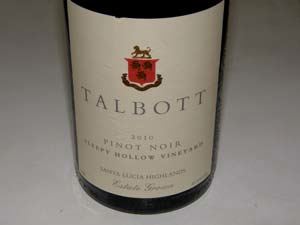 2010 Talbott Sleepy Hollow Vineyard Estate Grown Monterey Pinot Noir 14.9% alc., pH 3.68, TA 0.64, $40. 50% Martini clone planted in 1972 and 50% Dijon clones ranging in age from 15 to 20 years, all from the finest blocks of Sleep Hollow Vineyard. 100% de-stemmed, aged 11 months in 20% new French oak barrels. · Medium reddish-purple color in the glass. Reserved but pleasing aromas of black fruits, violets, tar and oak. Very pretty mid-weight fruited core offering flavors of black currents and blackberries balanced beautifully with ripe tannins and acidity. Impressive freshness, polish, lift and finish. Still relatively reserved and needs time in the cellar, but this wine clearly speaks loudest of Sleepy Hollow Vineyard terroir.
The Other Guys (Moobuzz, Pennywise, Leese Fitch) A separate division of Don Sebastiani & Sons that started as a sales division of a new family venture in 2004, it was spun off completely from Don & Sons (Aquinas, The Crusher, Smooking Loon, Pepperwood Grove) in 2010 by the three children of Don and Nancy Sebastiani (Donnie, August and Mia). This innovative brand is directed at restaurants and retailers and is especially appealing to millennial wine drinkers with names like Hey Mambo, moobuzz, and Plungerhead, and the incorporation of new packaging like screwcaps and Zork closures.
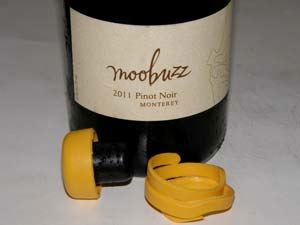 2011 Moobuzz Monterey Pinot Noir 13.5% alc., pH 3.68, TA 0.61, 5,400 cases, $15, Zork closure. 86% Monterey, 10% Mendocino, 4% Lodi. 86% Pinot Noir, 10% Sangiovese, 3% Tempranillo, 1% Syrah. · Moderately dark reddish-purple color in the glass. Very fragrant with bright aromas of dark red fruits, rose petals, spice and a hint of spicy oak. Plenty of Pinot fruit singing with enough fine-grain tannins to add a pleasing mouthfeel and enough oak in the background to compliment the fruit and lend the wine some credence. A simple, but satisfying wine. Good.
2011 Pennywise California Pinot Noir 13.5% alc., pH 3.64, TA 0.58, 27,000 cases, $11. Primarily sourced from the Merwin Vineyard in Clarksburg with contributions from vineyards in Monterey, Santa Barabara, Solano County, Lodi and the Sierra Foothills. 90% Pinot Noir, 6% Barbera, and 4% Sangiovese. · Light red color in the glass. Nicely perfumed with aromas of fresh cherries and sandalwood. Light flavors of cherries, cranberries and strawberries with mild tannins and no oak in sight. Soft in the mouth, and easy to drink. A pleasant, straightforward Pinot Noir that is true to the varietal. A good back porch wine. Good.
2011 Leese-Fitch California Pinot Noir 13.5% alc., pH 3.58, TA 0.56, 30,000 cases, $10.50, Zork closure. 76% Pinot Noir, 13% Syrah, 6% Grenache, 5% Barbara. 23% Monterey, 21% Lodi, 18% Clarksburg, 14% Mendocino, 9% Sierra Foothills, 8% Northern Interior Valley, 7% Santa Barbara. · Medium reddish-purple color in the glass. Aromas of strawberries, red cherries, raspberries, smoky oak and campfire. Medium weight core of red cherry and raspberry flavors with a smoky, woody undertone. Juicy and easy to drink with mild fine grain tannins. Fruit tends to fade rather quickly over time in the glass. Decent.
Twomey Cellars Brothers David and Tim Duncan are the Managing Partners of Twomey Cellars, which is separate from Silver Oak Cellars that is also owned by the Duncan family. The primarily Pinot Noir Twomey winemaking facility is located on Westside Road in the Russian River Valley and the Merlot winery is in Calistoga. The intent at Twomey Cellars is to produce appellation-designated Pinot Noirs (Anderson Valley, Sonoma Coast, and Russian River Valley) unless the wine is sourced from a single vineyard of special pedigree (Bien Nacido Vineyard in the case of Santa Barbara County). The initial winemaker at Twomey Cellars was Daniel Baron who now functions as winemaker for Twomey Merlot and oversees winemaking at both the Calistoga and Healdsburg wineries. The Pinot Noir (and Sauvignon Blanc) winemaker is Ben Cane, who has infused an enthusiasm and refinement into the wines which is clearly apparent in the 2010 vintage.
2010 Twomey Bien Nacido Vineyard Santa Maria Valley Pinot Noir 13.5% alc., pH 3.50, TA 0.63, 1,100 cases, $50. Released September 29, 2012. The backbone of this wine comes from Blocks 1, 7 and 9, all organically farmed hillside plantings. This is the first vintage that grapes were obtained from Block N, one of the original 1972 plantings of own-rooted Martini clone. Aged 15 months sur lies in 35% new and 65% once-used French oak barrels. · Medium reddish-purple color in the glass. Demure aromas of dark red cherries and berries with hints of rose petals, spice and underbrush. Moderately rich with an array of red and black berry flavors supported by svelte tannins and lifted by bright acidity. Elegant and soft in the mouth, with an impressively long, crisp finish. Much more expressive and enjoyable the following day from a previously opened and re-corked bottle showing hi-tone aromas of cherries, exotic woods and spice. Will need the most cellaring of all the 2010 Twomey Pinot Noirs, but will be well worth the wait.
Chardonnays to Admire100 years ago, Ernest Wente took cuttings from the south of France and planted them at Wente Vineyards in Livermore, California. Today, over 80 percent of Chardonnay produced in California comes from some version of the Wente clone. Chris Thorpe who owns Adastra vineyard and Adastra Wines in Carneros, has a good summary on his website (www.adastrawines.com) about the twisted history of Old Wente Chardonnay clone. Much of his information came from the article written by Gerald Asher in Gourmet (May 1990), “Chardonnay: Buds, Twigs and Clones.” In 1882, Charles Wetmore, the President of the California State Viticultural Commission and owner of Cresta Blanca Winery brought back budwood cuttings from Meursault in Burgundy. The budwood was then established in vineyards in the Livermore Valley of California. In 1912, a member of the Wente family (reportedly Ernest) went to France and took cuttings from the University of Montpellier viticultural nursery. These cuttings took a prominent place in the Wente vineyards in Livermore, along with cuttings taken from the Gier Vineyard which had used some of Wetmore’s budwood. Budwood taken from Wente vineyards by other winegrowers became known as “Wente.”
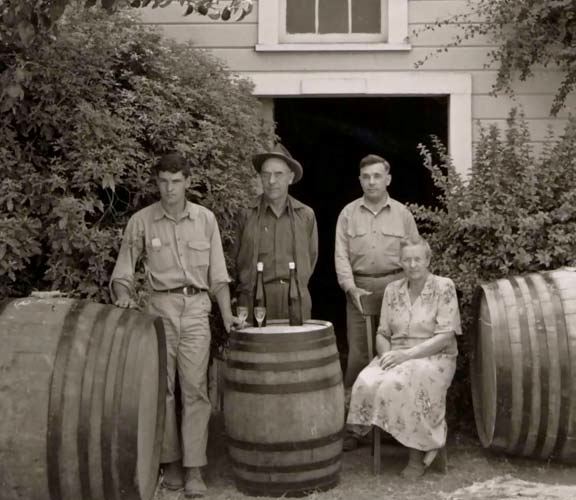
In 1948, Fred and Eleanor McCrea obtained budwood from Wente’s vineyard for planting at their Stony Hill Vineyard in Napa. Louis Martini took budwood from Stony Hill and referred to it as “Wente.” Budwood from some of Martini’s vines, as well as Wente plantings in Livermore and the nursery established in Arroyo Seco by Karl Wente, were taken to the Foundation block at University of California at Davis by Howard Olmo beginning in 1955. Olmo selected material that appeared to be disease free and had good yields. At the Foundation block, the vines were grafted, tested and certified as Foundation Plant Materials Service (F.P.M.S.) clone 4. This clone is referred to as the “Wente” or “heat treated Wente.” Non-certified budwood, like that taken by the McCreas, is referred to as “Old Wente.” The most common Chardonnay Dijon clones planted are 96 and 95, both traced to Meursault, France, and 76, traced to the Saone et Loire region of France. Dijon clones of Chardonnay are particularly desirable in Oregon because they give better yields than the Wente clone, and they ripen earlier. Wente clone can make excellent Chardonnay in Oregon, but there are only about 10 acres of old Wente plantings remaining in the Northern Willamette Valley as most of the Wente plantings have been displaced by Dijon clones. Todd Hansen of Longplay in Oregon who sells some of his Wente selection to J. Christopher, told me the Rex Hill "old Vine" Chardonnay is a 30-year-old Wente selection, Crowley's Chardonnay is mostly Wente. Jay Christopher, Josh Bergstrom, and Nancy Ponzi all profess a love for Wente selection.
2011 Briceland Vineyards Humboldt County Chardonnay Table wine, 135 cases, $21. Raised in stainless steel, no malolactic fermentation. · Light straw hue in the glass. Faint aromas of butter, pink grapefruit, ocean air and yeast. Nutty and citrusy in a reserved style with a smooth, easy drinking manner. Good.
2011 Briceland Vineyards Humboldt County Sauvignon Blanc Table wine, 128 cases, $18. · Pale straw color in the glass. Typical varietal aromas of grass, herbs and citrus. Crisp and refreshing with flavors of lime zest, hay, grass, grapefruit with a mineral undertone. A grassy style with a pleasing mouthfeel and a dry finish. Good.
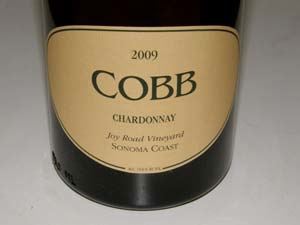 2009 COBB Joy Road Vineyard Sonoma Coast Chardonnay 13.6% alc., 95 cases, $80. Dijon clone. · Golden straw color in the glass. Welcoming aromas of white peaches, honey, banana and pastry cream. Delicious flavors of baked pear, toasted almonds, and lemon curd, finishing with noticeable length. Soft and smooth with bright but well integrated acidity. A delight. Very good.
2011 Craggy Range Kidnapper’s Vineyard Hawkes Bay New Zealand Chardonnay 13.0% alc., $19, screwcap. Imported by Kobrand Corp, NY, NY. · Very pale straw color in the glass. Fresh aromas of green apples, lychee and marzipan. Crisp, juicy and slightly viscous on the palate with flavors of citrus, baked pear, apple galette, and walnuts, finishing upbeat with a good cut of citrusy acid. Very good.
2009 Dehlinger Estate Bottled Russian River Valley Chardonnay 14.9% alc., $37. · Golden straw color in the glass. Primarily oak-driven aromas of toast, fresh brioche, and brown butter with a hint of yeastiness. Richly flavored with a core of apple, baked pear, lemon, toffee, and roasted nuts. Relatively low in acid, finishing dry with a bit of heat. Good.
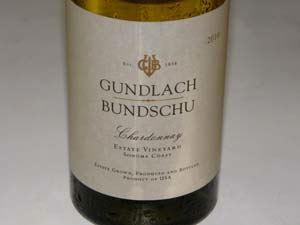 2010 Gundlach Bundschu Estate Vineyard Sonoma Coast Chardonnay 14.2% alc., pH 3.48, TA 0.67, 3,018 cases, $27. Released March 2012. From two blocks of 40+year-old Wente selections and two blocks of Robert Young clone. Yields 2.8 tons per acre. Whole cluster pressed, 80% barrel fermented and 20% stainless steel fermented, indigenous and inoculated yeasts, weekly battonage, no malolactic fermentation, aged 10 months in 20% new French oak barrels. · Light straw color in the glass. Clean aromas of golden apple, lemon, yeast and nasturtium. Polished and crisp, with flavors of apple, Asian pear, malted milk and toast, with an appealing underpinning of minerality. Impeccable balance, on-point focus and refreshing to drink. Very good.
2010 Patz & Hall Sonoma Coast Chardonnay 14.2% alc., $35. Sourced from Gap’s Crown, Durell, Dutton Ranch, Sun Chase, and Parmalee Hill vineyards. Whole cluster pressed, indigenous yeast fermentations, aged sur lie with weekly stirring, 100% malolactic fermentation in barrel, aged in 40% new French oak barrels, and bottled without filtration. · Pale straw color in the glass. Pleasant perfume of baked pear, honey and toast. Moderately rich with a comforting smoothness, featuring lemony, nutty, toasty flavors with a hint of toffee, leaving some lemon-driven scent on the lively finish. Seamless and thoroughly enjoyable. Very good.
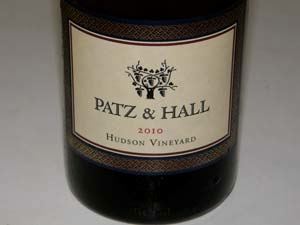 2010 Patz & Hall Hudson Vineyard Napa Carneros Chardonnay 14.2% alc., 454 cases, $55. Hudson Vineyard was founded in the 1980s by Lee Hudson and is considered one of the grand cru sites in Carneros. Sourced from a 4-acre block that is planted to the Hudson- Wente selection. Whole cluster pressed, indigenous fermentations, aged sur lie with weekly stirring, 100% malolactic fermentation in barrel, aged in 60% new French oak barrels, and bottled without filtration. · Light straw color in the glass. The wine draws you in with appealing aromas of honey, lemon curd, roasted almonds and toasty oak. Moderately rich on the attack with luscious flavors of baked pear, lemon peel, and toffee, finishing soft and comforting with a refreshing brightness due to harmonious citrus-driven acidity. Choose any superlative you want. A masterpiece and one of the greatest California Chardonnays I have tasted this year.
2010 Patz & Hall Dutton Ranch Sonoma Coast Chardonnay 14.2% alc., $42. A vineyard designate for Patz & Hall since 1998. A blend from seven blocks of Chardonnay farmed by the Dutton family, largely planted with California heirloom selections (Robert Young, Rued, Hyde-Wente, and UCD clone 4). Whole cluster pressed, indigenous yeast fermentations, aged sur lie with weekly stirring, 100% malolactic fermentation in barrel, aged in 45% new French oak barrels. · Pale straw color in the glass. Aromas of peach, Asian pear, coconut and sawmill lead to very tasty flavors of baked peach, pear, lemon curd, cocoa and toffee. Very smooth in the mouth with well integrated supporting acidity, finishing bright and clean. Very well crafted and highly enjoyable, but not quite the flavor impact of the Hudson Vineyard offering. Very good (+).
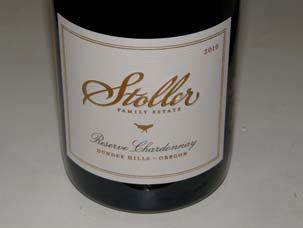 2010 Stoller Family Estate Reserve Dundee Hills Oregon Chardonnay 13.5% alc., pH 3.31, TA 0.73, 883 cases, $28. Composed of high-density Dijon clone material (76, 95 and 96). Whole cluster pressed, commercial and native yeast fermentations, aged sur lies for 10 months in 18% new, 9% second fill and 73% neutral French oak barrels with battonage, cold stabilized and sterile filtered before bottling. · Pale gold color in the glass. Very fresh perfume of pears, lemon peel, honey and vanilla cream. Flavorful, with a core of green apple, pear, lemon and grapefruit flavors with a slight flinty note, finishing dry and slightly tart. A high acid rendition of Chardonnay that is primarily citrus driven. Very good.
2010 Varner Home Block Spring Ridge Vineyard Santa Cruz Mountains Chardonnay 13.4% alc., $37. · Golden straw color in the glass. Brisk aromas of lemon cream, apple and rocky shoreline. Flavors of green apple and lemon predominate with a crisp lemon-lime fueled finish. Slightly nutty, with a peculiar celery stalk note. Very smooth on the palate and easy to drink, but leans heavily on acidity. Good.
New Zealand Pinot Noir: Hot or Not?Noted UK wine writer Jamie Goode recently tweeted, “Bold statement: within 10 years New Zealand could be known for making the world’s consistently best Pinot Noir and Syrah.” The latest figures show that New Zealand is now exporting well over one million cases of Pinot Noir a year and in all markets outside of the United States, New Zealand Pinot Noir ranks second only to Burgundy in sales. New Zealand Pinot Noir is hot. Maybe not. The Wall Street Journal (Lettie Teague, September 1, 2012) recently offered an article titled, “What Happened to New Zealand Pinot Noir? Teague points out that she has noticed less New Zealand Pinot Noir on this country’s wine lists and retail store shelves and attributes this to a number of factors including loss of distributors during the recession of 2008-09, the unfavorable exchange rate which keeps prices relatively high, and poor brand recognition outside of a few high profile labels. My personal experience with retailers in California is that the showpiece New Zealand Pinot Noirs from recognizable wineries such as Ata Rangi, Cloudy Bay, Craggy Range, Escarpment, Felton Road, Peregrine, Pyramid Valley, Quartz Reef, Rippon, and Spy Valley still appear regularly in fine wine retailers stock, but some bottles languish on the shelves for extended periods, and retailers do not push the wines using featured tastings or publicity. New Zealand Pinot Noir just doesn’t seem to generate much buzz currently among stateside wine connoisseurs because the competition from California and Oregon Pinot Noir is formidable. The New Zealand Pinot Noirs simply don’t offer enough of a distinct contrast to North American Pinot Noir to make them preferable. New Zealanders such as writer Geoff Kelly have been critical of New Zealand Pinot Noir, pointing out that a noticeable number of his country’s Pinot Noirs lack body and concentration, something the American palate cherishes, too many are either under-ripe or overripe or exhibit flavors of both, and some wines can be overwrought with acidity, something American consumers generally disdain. That said, I try to taste New Zealand Pinot Noir periodically out of curiosity, and over the years have acquired quite a fondness for the Pinot Noir from Felton Road, Rippon, and most recently, Burn Cottage. A few wines primarily from the excellent 2010 vintage that I tasted recently are reviewed here. Some producers in New Zealand have claimed that 2010 is the best ever for Pinot Noir in that country. Many New Zealand producers of premium Pinot Noir are committed to screwcap closures.
2009 Burn Cottage Central Otago Pinot Noir 14.0% alc., 1,136 cases, $50. Imported by Classic Wines LLC, Denver, CO. Estate grown and bottled by the American Sauvage Family in Cromwell. Consulting winemaker and partner is Ted Lemon of Littorai. · Moderately dark reddish-purple color in the glass. Deep, penetrating aromas of chocolate covered black cherries, compost, slate and seasoned oak. Intense mid palate attack of ripe black raspberry and black cherry fruit backed by supple tannins, finishing with some length. An earthy, mineral underpinning adds interest and complexity. Highly flavorful, but elegantly styled. Very good.
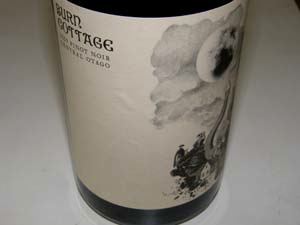 2010 Burn Cottage Central Otago Pinot Noir 13.7% alc., $50 (sold out at winery). Imported by Classic Wines LLC, Denver, CO. · Moderately dark reddish-purple color in the glass. Shy initially, picking up interest and intensity over time in the glass to reveal enticing aromas of dark red fruits, exotic spices and forest floor. Good attack of tasty black cherry, dark red raspberry and dark plum fruit supported by firm, ripe tannins and lifted with bright acidity. Very juicy and pleasing, becoming more intense over time in the glass. Flat-out great the next day from a previously opened and recorked bottle, showing a slip of its true potential including a marvelous peacock tail grand cru finish.
2010 Craggy Range Te Muna Road Vineyard Martinborough New Zealand Pinot Noir 14.0% alc., $35, screwcap. Imported by Kobrand Corp, NY, NY. Indigenous yeast fermentations, aged more than a year in French oak barrels without racking. · Medium reddish-purple color in the glass. Slight reduction and oaky upon opening, becoming very savory over time with aromas of bramble, herbs and wild, dark red berries. Fruits in the redder spectrum are featured with a green, herbal tone. Moderately light in weight with supple tannins and an acid-driven, juicy finish. Good.
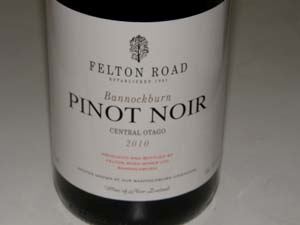 2010 Felton Road Bannockburn Central Otago New Zealand Pinot Noir 14.0% alc., $40, screwcap. Imported by Wilson Daniels, St. Helena, CA. 100% organic and biodynamic viticulture. 20% whole cluster. Wild yeast fermentations, aged 11 months in French oak barrels, unfined and unfiltered. · Moderately dark reddish-purple color in the glass. Aromas of black cherry liquor, black raspberries, blackberries and oak toast. Moderately rich with impressive mid palate presence, a seductively plush mouth feel, and a lengthy finish featuring black raspberry fruit. Oak plays a supporting role and the tannins are well-managed. The most impressive features are the soft, polished texture and the impressive concentration of the fruit.
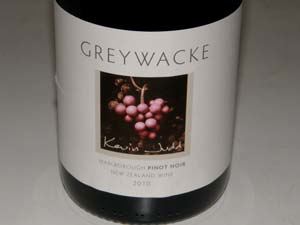 2010 Greywacke Marlborough New Zealand Pinot Noir 14.0% alc., pH 3.65, TA 0.56, $35, screwcap. Released February 2012. This winery is named after New Zealand’s prolific bedrock and the label displays the name of proprietor Kevin Judd, one of Marlborough’s pioneering winemakers. Fruit is sourced from mature vineyards within the central Wairau Plains and the Southern Valleys. Predominately Dijon clones 115, 777 and 667, with smaller amounts of Pommard and AM 10/5. Most of the fruit was de-stemmed with some whole bunch inclusion. Indigenous yeast fermentation, hand punch downs, aged in 45% new French oak barrels for 15 months and fined for clarity before bottling. The wine is made at Dog Point Winery in the Brancott Valley. Imported by Old Bridge Cellars, Napa, CA. · Medium reddish-purple color in the glass. Nicely perfumed with aromas of dark berry jam, spice, forest floor and a hint of black cherries. Earthy with flavors that echo the nose, becoming richer and more enticing over time in the glass. Silky, with soft tannins and a good cut of acidity on the finish. Still fine the following day from a previously opened and re-corked bottle. Very good and worth seeking out.
2010 Soho McQueen Central Otago New Zealand Pinot Noir 14.0% alc., $27, screwcap. Imported by Nedrac Inc., Palm Desert, CA. Winemaker is Grant Taylor. · Moderately dark reddish-purple color in the glass. Very ripe aromas of raisin, black plum and dark chocolate. Dark, earthy, ripe fruits are featured, highlighted by citrus-laden acidity that persists on the finish. The acidity brings the wine freshness, but is a bit imposing. Decent.
2010 Saint Clair Family Estate Vicar’s Choice Marlborough New Zealand Pinot Noir 13.5% alc., $14, screwcap. Imported by Winesellers LTD, Niles, IL. Owners Neal and Judy Ibbotson have a relative who was a vicar in the Anglican Church. On a visit to Saint Clair, the vicar selected his favorite barrels and the name was born. The winemaker is Matt Thomson. · Moderately light reddish color in the glass. Fresh aromas of dark red strawberries, raspberries and cherries. Fruit-driven, featuring red fruits with complimentary oak in the background. Elegantly styled and smoothly textured with mild tannins and a grapefruit-peel note on the finish. A relatively straightforward drink that offers value. Good.
BevMo! 5¢ Sale: Pinot Buyer BewareBevMo! is a large chain retailer of wine, beer and spirits with over 100 stores located in California, Arizona and Washington. Founded in 1994 as Beverages and More!, BevMo! is a privately held corporation. The company has its own wine reviewer, Wilfred Wong, who was hired in 1995. A veteran wine writer and wine judge, he assesses the retailers wines and scores them on a 100-point system. Wong also writes a blog on the company’s website, and reportedly tastes 8,000 bottles of wine a year for BevMo! Obviously his role creates a potential conflict between scoring wines favorably and the company’s business plans for the wines. I have no idea whether he tastes the wines blind, but he claims that he is not influenced by wine salespersons, distributors or BevMo!’s buyers. He tends to be liberal, however, with his scoring as I discovered recently. Currently, BevMo! features a promotion called “The World’s Best Wine Sale,” in which certain wines are offered for sale, and when the buyer purchases one wine, he gets the second bottle of the same wine for 5¢. A number of well-known brands of Pinot Noir that are stocked at the store are not part of the promotion, but three inexpensive ones were at the store I visited: 2010 Babcock Sta. Rita Hills Pinot Noir, 2011 DeLoach California Pinot Noir, and 2011 Irony Russian River Valley Pinot Noir. I counted 38 Pinot Noirs (mostly from California) with labels I had never heard of available for pickup at the store in my neighborhood and listed on the website. All were priced under $30, and many of the wines were reviewed very favorably by Wong (scores ranging from 87 to 94 points). 17 received scores of 90 or above: Archaic (90), Heliotrope (90), Contrada (90), Craftwork (92), Dahlia (91), Donovan-Parke (90), Frog Haven (90), L’Attitude (90), Longhand (94), Michael Pozzan (90), Quimay (91), Ranch 32 (92), Row 503 (90), Sonoma Landing (91), Stanza (90), Triplebank (91) and Zinnia (92). Most of the labels do not have websites and a number are labels made by wineries and sold exclusively to BevMo! I have never seen or heard of most of these labels, and none of them are in my website Winery Directory which lists 1841 wineries, mostly from North American, that produce Pinot Noir. I pride myself in keeping up to date on producers, but was astonished to find so many producers previously unknown to me with bottlings priced under $30 that were reviewed so favorably. I visited my local BevMo! retailer and randomly selected six Pinot Noirs from the shelves. Five were part of the 5¢ Sale promotion and five had been rated by Wong as deserving scores of 90 to 94. The one wine (Valley of the Moon) not scored by Wong had won a Gold Medal at the 2012 California State Fair Wine Competition. These wines were essentially blind tasted since I had no previous familiarity with any of the producers. None of the wines tasted were of outstanding (Geek Icon) or even Very Good quality. Two of the wines were Good and represented good value, especially at the 5¢ Sale promotion pricing. Two of the wines were Decent, and two of the wines were Unsatisfactory, one of which had been awarded a score of 94 points. My conclusion was buyer beware when searching the shelves at BevMo! for good quality Pinot Noir especially when you come across unfamiliar labels. You can find some good wines at reasonable prices, but be careful when gambling on unknown wines, regardless of the shelf talker and score. Like everything else, but especially for Pinot Noir, you get what you pay for, and I have never seen a really good Pinot Noir offered at what is essentially a 2 for 1 pricing at BevMo!
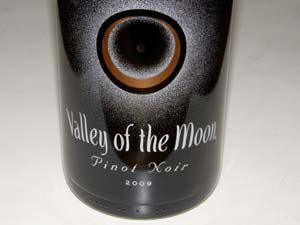 2009 Valley of the Moon Carneros Pinot Noir 13.5% alc., $24.99. · Moderately light reddish-purple color in the glass. Perfumed with aromas of strawberries, cherries, and spice. Light in weight, but decent strawberry and blueberry flavors, offering easy drink ability. The tannins are soft and mellow, and the finish offers a cherry tang with a hint of oak. Good, especially attractive at the 5¢ Sale promotion price.
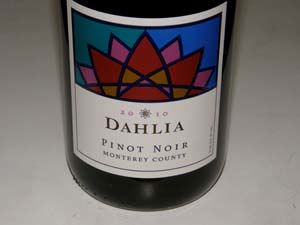 2010 Dahlia Monterey County Pinot Noir 14.4% alc., $19.99, screwcap. WW 91. Produced by Testarossa Winery and sold exclusively to BevMo! · Moderately light reddish-purple color in the glass. Nice array of aromas including dark red fruits, rose petals and seasoned oak. Light weight flavors of vanilla-infused black cherries and dark red berries, with a cherry-driven finish. The wine has a good spark of acidity and supple tannins, with a noticeable oak presence in the background. Good.
2010 Michael Pozzan Russian River Valley Pinot Noir 13.9% alc., $24.99. WW 90. · First bottle: Light reddish-purple hue in the glass. Aromas of black cherry and cola, veering to the overripe side, with hints of charcoal and oak. Mid weight core of black raspberry and black cherry fruit with some green oak in the background, finishing with a prominent cut of acidity. Drinkable, but no message. Decent. Second bottle: Moderately light reddish-purple hue in the glass. Aromas of Bing cherries, briar, smoky oak and oak spice. Light and elegant with prominent acidity, featuring flavors of deep red cherries and berries with noticeable oak and stem in the background. Decent at best.
2009 Craftwork Estate Grown Monterey Pinot Noir 13.9% alc., $29.99. WW 92. · First bottle: Very light reddish-purple color in the glass. Pleasant aromas of red fruits and sandalwood. Light weight, tasty flavors of red cherries and berries with a hint of candied rose petals, finishing short, tart, slightly astringent and mildly oaky. Decent at best. Second bottle: Very light reddish-purple color in the glass. Aromas of red cherries, red berry jam and sandalwood. Brisk and juicy, with lightweight flavors of dark red cherries with a noticeable riff of oak and a green, steely note in the background. Decent at best.
2010 Longhand Sonoma Coast Pinot Noir 13.5% alc., $24.99. WW 94. Not part of the 5¢ Sale promotion. · Moderately light reddish-purple color in the glass. Very ripe nose exhibiting aromas of raisins, beef jerky and grilled plums. Porto, roasted fruit flavors with flamboyant finishing tannins that overwhelm the mid weight fruit. Unpleasant and Unsatisfactory.
2008 Contrada Sonoma Coast Pinot Noir 14.1% alc., $19.99. WW 90. From Michael Pozzan Winery in Oakville. · First bottle: Light reddish-purple color with a slight brickish rim. Volatile acidity upon opening which blows off revealing aromas of overripe, roasted fruit, and prune, mahogany and pharmaceutical cabinet. Woody black cherry flavor, firm tannins, in an elegant, soft style. Rather unpleasant to drink. Unsatisfactory. Second bottle: Moderately light reddish-purple color in the glass. Nondescript nose. Flavors of tar, creosote, rubber, and oak with little fruit. Unpleasant and out of sorts. Surely a smoke tainted wine. Unsatisfactory.
Portland Monthly: Oregon’s 50 Best Wines
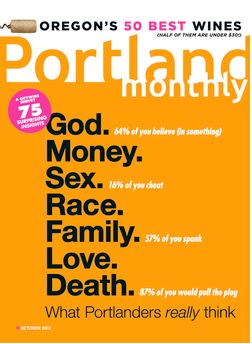 In the September 2011 issue of Portland Monthly, “Oregon’s 50 Best Wines” was featured. The results were compiled by a distinguished tasting panel who sampled blind a broad range of Oregon wines (103 producers). Every one of the wines in the top 35 were Pinot Noir. The top 10 results and scores (wines reviewed in the PinotFile are noted by *):
1. 2008 Soter Vineyards Mineral Springs Yamhill-Carlton Pinot Noir $85, 96 * 2. 2008 Utopia Vineyard Utopia Vineyard Ribbon Ridge Pinot Noir $38, 95 3. 2008 1789 Wines Single Vineyard Chehalem Mountains Pinot Noir $48, 94 4. 2008 Daedalus Cellars Maresh Vineyard Dundee Hills Pinot Noir $60, 94 *
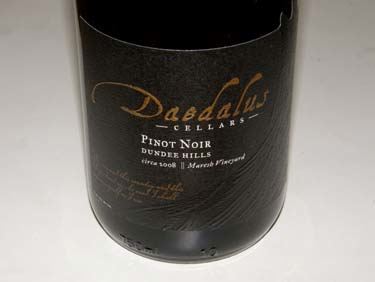 5. 2009 Andrew Rich Prelude Willamette Valley Pinot Noir $22, 94 * 6. 2009 Broadley Vineyards Claudia’s Choice Willamette Valley Pinot Noir $50, 93 7. 2008 ROCO Winery Private Stash #6 Chehalem Mountains Pinot Noir $70, 93 *
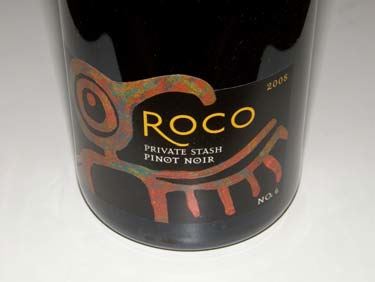 8. 2008 Thistle Dundee Hills Pinot Noir $28, 93 9. 2009 Rex Hill Vineyards Willamette Valley Pinot Noir $33, 92 10. 2009 Bergström Wines De Lancellotti Chehalem Mountains Pinot Noir $60, 92
In the September 2012 issue of Portland Monthly, “Oregon’s 50 Best Wines” was again featured. The tasting panel blind tasted 578 bottles from 175 wineries. More than half of the wines in the top 50 were priced less than $30, including three in the top 10. The top 10 wines, all Pinot Noir, are listed below with scores (wines reviewed in the PinotFile are noted by *): 1. 2010 White Rose Estate Appellation Series Dundee Hills Pinot Noir $45, 98 2. 2010 White Rose Estate White Rose Vineyard Dundee Hills Pinot Noir $70, 98 3. 2010 Elk Cove Willamette Valley Pinot Noir $27, 97 4. 2010 St. Innocent Zenith Vineyard Eola-Amity Hills Pinot Noir $36, 97 *
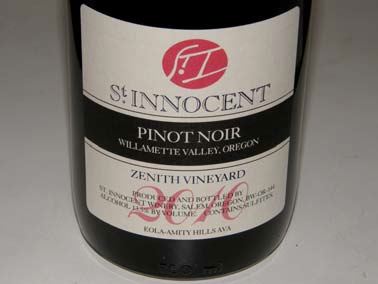 5. 2009 Willamette Valley Vineyards Estate Willamette Valley Pinot Noir $45, 95 6. 2009 Atticus Wine Atticus Vineyard Yamhill-Carlton Pinot Noir $42, 95 7. 2010 Walter Scott Holstein Vineyard Dundee Hills Pinot Noir $38, 95 8. 2009 Apolloni Vineyards Estate Willamette Valley Pinot Noir $26, 94 9. 2009 Tyee Wine Cellars Estate Willamette Valley Pinot Noir $24, 94 *
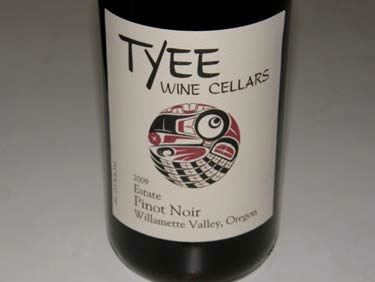 10. 2010 Evesham Wood Vineyard Le Puits Sec Eola-Amity Hills Pinot Noir $36, 94 *
Pinot BriefsSlowdown in Immigration Challenges Winegrowers As reported in The Press Democrat (September 16, 2012), there is a dwindling supply of vineyard workers because fewer field workers are immigrating from Mexico, and many laborers are returning to Mexico from the United States. The article cites data from the Pew Hispanic Center that show between 1995 to 2000, nearly 3 million people migrated from Mexico to the United States, and only 670,000 left. From 2005 to 2010, only 1.37 million entered the United States from Mexico, while 1.39 million returned. Historically, many vineyard works from Mexico entered the United States at the time of harvest and returned to Mexico for the winter, eventually acquiring citizenship so they could cross the border legally. However, vineyard workers who immigrated here over the years are aging and retiring, and their children have no interest in pursuing the same work. I have talked to winegrowers in California and Oregon and they tell me American-born Caucasians simply won’t do this kind of work. Even during the recession during the 2008 and 2009 vintages, when many Americans were out of work, they could not be coaxed into doing this type of hard labor. Oregon Statistics OregonLive.com (September 8, 2012) reports the following data for Oregon. 758 winery licenses were issued in the last year (an increase from 632 two years ago), of which about 500 are traditional wineries. $159 million is generated by wine related tourism in Oregon annually. Bottles of wine are taxed at the rate of 67 cents a gallon or about 17 cents a bottle. Oregon residents spent $740 million on alcoholic beverages in 2010, only slightly less than they spent on fruits and vegetables. Coverage of Oregon Pinot in the City This extensive tasting of wines from 70 top Oregon wineries was held in San Francisco on Thursday, September 12, 2012. Richard Jennings, who writes RJonWine.com (www.rjonwine.com) provided extensive coverage. Somehow he managed to taste, review and score 144 wines from 59 producers during the four-hour tasting. That is about one wine every two minutes. I asked him how he accomplishes this iron man achievement and he told me the following. “I’ve trained myself to do it over a period of 9 or 10 years now. It’s a very dubious talent, but it’s one I’ve keenly developed. I am, if you will, the Michael Phelps of massive trade tasting events. I have found, over many years of doing this, that my scores are valid and I end up within a point or with the identical score when I re-taste the same wine in a more leisurely setting.” Richard covers the world of wine extensively and I highly recommend his website. Fastest Growing Wine Grape Varieties in California Fred Swan, at www.norcalwine.com, reported September 4, 2012, the following. 56% of the 77,000 acres of new vineyards planted in California in the past five years (bearing and non bearing) were devoted to red-grape varieties. Pinot Noir showed the most increase in new acreage of all wine varieties: 8,529 new acres planted between 2007 and 2011. Total Pinot Noir plantings as of 2011 were 39,273 acres. The counties with the greatest increase in Pinot Noir vineyards were Monterey, Santa Barbara and Sonoma. Chardonnay showed the second largest increase in new acreage and Cabernet Sauvignon was third.
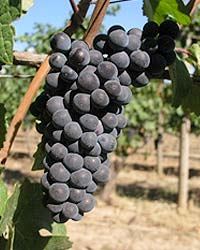 Wine & Wall San Francisco Wine & Wall is a new wine store, wine bar event site, and art gallery in San Francisco adjacent the Lark Creek Restaurant Group’s One Market Restaurant. All the wines that are stocked are chosen because of their attention-getting labels. James Blackwelder is the certified sommelier who choses the wines along with a tasting panel, but he reassures customers that quality is not being sacrificed for label visual appeal. No Pinot Noirs are currently featured (Haven’t they seen Eric Kent’s labels?). Visit www.wineandwall.com. Amazon Enters Wine Business According to Wine Industry Insight, Amazon will be offering wine for sale from Napa and Sonoma in time for the holidays through online promotions. Wineries committed to this program are so far hush, hush about it. The program became feasible with the passage of California’s 2011 ruling that allows unlicensed, third-party vendors to promote wine sales as long as they do not sell the wines directly. Amazon will be able to obtain very low shipping rates for wineries do to the vast business they do with UPS. Read more in Wine Executive News (by subscription). Wine Shipping Sales top $1.35 Billion According to ShipCompliant and Wines & Vines, the winery shipping channel has grown to $1.35 billion, representing 8.6% of the total United States wine retail market (12-month period ending July 2012). The volume of wine shipped direct to consumers increased 7.2% over the previous 12-month period, while the value of shipments increased by 10.3%. Cabernet Sauvignon, Pinot Noir and Chardonnay account for nearly 60% of all wines shipped during the period and the total dollar value represented by these three varietals is 72%. Larger wineries saw the greatest percent increase in volume of wines shipped. California is by far the top state for winery-to-consumer shipments. The Direct-To- Consumer Shipping Reportis available for download free at www.shipcompliant.com/shippingreport. Tickets to ¡Salud! The Oregon Pinot Noir Auction On Sale Wineries will be debuting Oregon’s 2011 vintage at this year’s auction. Tasting and Big Board Auction is at Domaine Drouhin Oregon on Friday, November 9, 2012 and the Dinner and Auction Gala is Saturday, November 10, 2012 at The Governor Hotel in Portland. Ticket price of $395 per person includes both events. ¡Salud! is partnering with the following Vintners Circle wineries in 2012: Adelsheim Vineyard, Amalie Robert Estate, Antica Terra, ArborBrook Vineyards, Archery Summit, Argyle, Ayres Vineyard, Beaux Frères, Bethel Heights, Brittan Vineyards, Brooks Winery, Chehalem, Cristom, Dobbes Family Estate, Domaine Drouhin Oregon, Dusky Goose, Elk Cove Vineyards, Erath Winery, Evening Land Vineyards, Hamacher Wines, King Estate Winery, Maysara Winery, Panther Creek Cellars, Patricia Green Cellars, Patton Valley Vineyard, Penner-Ash Wine Cellars, Ponzi Vineyards, R. Stuart & Co., Raptor Ridge Winery, Scott Paul Wines, Shea Wine Cellars, Sokol Blosser, Soléna Estate, Soter Vineyards, St. Innocent Winery, Stoller Family Estate, Torii Mor, Trisaetum, WillaKenzie Estate, Willamette Valley Vineyards, Winderlea Vineyard & Winery, and Witness Tree Vineyard.
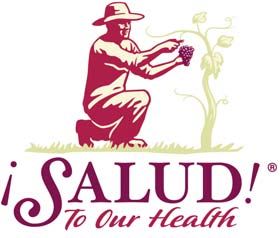 Pinot Days Dates Announced The fall 2012 and 2013 events: Los Angeles, November 11, 2012, 80 producers (tickets at $70 per person on sale now); New York, January 26, 2013, 65 producers; Chicago, April 30, 2013, 65 producers; San Francisco, June 22, 2013, 190 producers. Visit www.pinotdays.com. Closure Debate Surfaces There has not been much in the news recently about closures until a fivepart series ran online at www.thedrinksbusiness, September 10-14, 2012. The articles profiled a trial performed by Chateau Margaux’s Paul Pontallier over ten years in what was called “the most high profile experiment in the history of the closure debate.” Pontallier had undertaken the trial in 2002 because a large number of wines from the Margaux property had a high level of TCA and screw caps had become available. He admitted that even though Margaux obtains the best natural corks available, TCA is still an issue (below 1% but still considered unacceptable). A set of three red wines from the 2003 vintage and three white wines from the 2004 vintage (from vineyards used for Pavillon Rouge and Blanc) were sealed using three different closures: natural cork and two screwcaps with different linings (Saratin and Saranex). The wines were offered to the UK Press for tasting in February 2012. Wines were also closed with synthetic corks, but were not shown as the results were deemed “catastrophic.” The press in attendance preferred the red wine aged under Saratin-lined screwcaps (impermeable to oxygen), but preferred the white wine sealed with natural cork, although most considered it very similar to the white wine sealed with a Saratin-lined closure. The Saranex screw cap, which is permeable, showed more oxidation and aromatic evolution for both red and white wines. No definite conclusions have been reached at this stage of the trial, and Pontallier feels he will have to wait another ten to twenty years to decide which closure is better. New Book for Wine Geeks Wine Grapes is a comprehensive look at 1,369 vine varieties including their origins and flavors written by Jancis Robinson, Julia Harding and José Vouillamox. To be released October 30, 2012, the book weighs in at 1,280 pages. It contains eight-page gatefolds revealing the family trees of grapes and a variety of full-color illustrations from old ampelography sources. Price is $175 ($110.25 pre-order price on amazon).
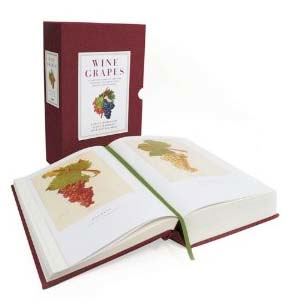 Other new books of interest include Vintner’s Apprentice: An Insider’s Guide to the Art and Craft of Wine Making, Taught by the Masters (Eric Miller, $15.99), How to Love Wine: A Memoir and Manfesto (Eric Asimov, $16.49), The Curious World of Wine: Facts, Legends, and Lore About the Drink We Love So Much (Richard Vine, Ph.D, $13.60), and The Organic Backyard Vineyard (Tom Powers, $13.57) Whole Cluster Trend Jamie Goode wrote an excellent article in The World of Fine Wine (Issue 37, 2012) in which he points out something that I have been aware of as well: an increasing number of the best producers in the Old and New Worlds are turning to the use of stems in red wine making. Burgundy and Pinot Noir have been most associated with whole cluster fermentation. In the article, Jasper Morris MW is quoted as saying, “In Burgundy at the moment there is a tendency to move toward stems. I can see two main reasons for this. One is that Henri Jayer, who hated stems, is dead. And the other is that with climate change, the stems are more often riper than they used to be.” Goode points out the benefits of whole bunch: (1) Delivers a textural smoothness or silkiness that is especially attractive in Pinot Noir, (2) The tannic structure is increased, (3) The aromatic expression of the wine is enhanced, (4) Freshness, and (5) The wines are more elegant. He concludes, “What was once seen as an outmoded practice is now becoming a fashionable winemaking tool for those seeking elegance over power.” The Navy Chief Wine Taster At a wine merchant’s warehouse the regular taster died, and the director was looking for a new one to hire. A retired Chief Petty Officer, drunk and with a ragged look came to apply for the position. The director wondered how to send him away. He decided to give him a glass of wine to taste. The old chief tried it and said, “It’s Muscat three years old, grown on a north slope, matured in stainless steel. Low grade, but acceptable.” “That’s correct,” said the director and handed him a second glass. “It’s a Cabernet, eight years old, southwestern slope, matured in oak barrels. Requires three more years for finest results.” “Absolutely correct,” repeated the director and handed him a third glass. “It’s a Pinot Blanc sparkling wine, high grade and exclusive,” calmly said the drunk. The director was astonished and winked at his secretary to suggest something. She left the room and came back with a glass of urine. The old Navy Chief tried it. “It’s a blonde, 26-years-old, three months pregnant, and if I don’t get the job, I’ll name the father.”
Wine For Dummies, 5th Edition
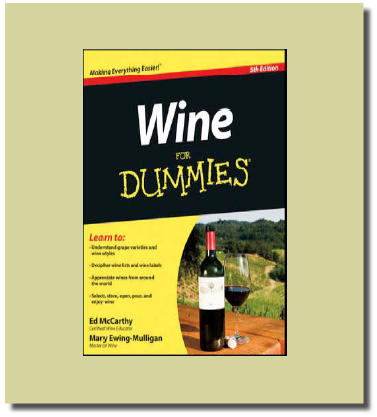 The latest edition of this very popular book has been updated to include online resources, new wine styles and vintages, best new wine values, new wineries and more. The first edition dates to 1995 and over the years the authors have refined their presentation so that this is clearly the most comprehensive book in the series. The wine knowledgeable authors are married, having met at an Italian wine tasting many years ago in New York. McCarthy is a noted wine journalist and Certified Wine Educator, and Ewing-Mulligan is a Master of Wine. Together they have more than a half century of wine experience between them. Ignore the title, for wine lovers at every level of expertise from novices (“Dummies”) to experienced wine connoisseurs will find this book a valuable reference. Millenials, in particular, and those who are new to wine, will find a treasure trove of practical information including how to shop for wine, how to properly taste wine, how to decode restaurant wine lists, how to describe wines, how to store wine properly, and most of all, how to pursue your love of wine. Special attention should be paid to the chapter, “Ten Wine Myths Demystified.” The book is written in understandable, plain-English, and includes an appendix with a pronunciation guide to wine terms and a glossary of wine terms. The text is replete with valuable tips, warnings, worthy searches, technical stuff and key points to remember indicated by appropriate markers ( a target with an arrow in the center for valuable tips, for example) in the left margins. A lengthy list of U.S. wine stores worth knowing, wine books worth reading, and newsletters and blogs worth seeking out to obtain further knowledge is invaluable for the uninitiated. My only nit is that there is no mention of the PinotFile. A companion website, www.dummies.com, is another source of information with articles such as “Understanding Wine Labels,” “Attending a Wine Tasting Event, and “Discovering How to Sniff a Glass of Wine.” Wine For Dummies, 5th Edition, Ed McCarthy and Mary Ewing-Mulligan, September 19, 2012, 432 pages, paperback, Wiley, $22.99. Also available in e-book format. |